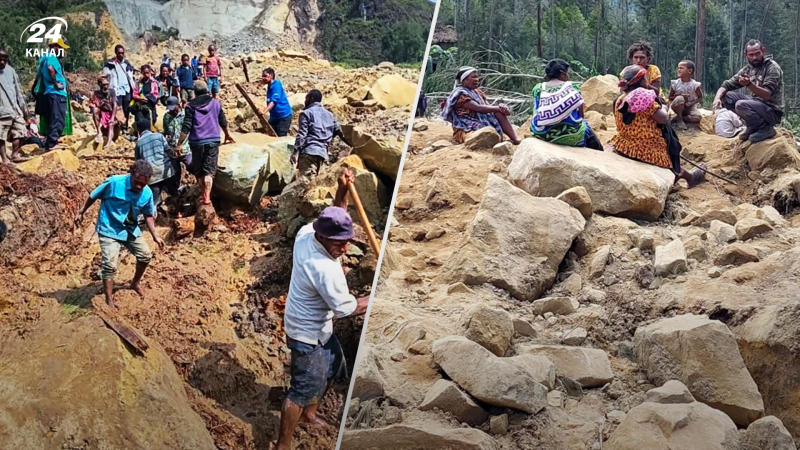A landslide occurred in Papua New Guinea/Collage 24 Channel/Photo AFP On Friday, May 24, in Papua A large-scale landslide occurred in New Guinea, which buried, according to some information, more than 2 thousand people. The landslide occurred early in the morning, when most people were sleeping. The rescue operation is complicated by the fact that the affected villages are located in difficult and remote terrain in the high mountainous province of Enga , and some of them lived in isolation. This reduces hopes of finding those who could survive under the rubble.There has been no census in the country since 2000< /h2>
A Papua New Guinea government spokesman told the UN that more than 2,000 people were buried alive in the landslide. However, the government figure is about three times higher than the UN estimate of 670 dead.
“We cannot deny what the government is proposing, but we cannot comment on it either “said Serhan Aktoprak, head of the UN migrant agency's mission in Papua New Guinea. last time in 2000. The government estimates Papua New Guinea's population at about 10 million, although a UN study based on data including satellite imagery of rooftops estimated in 2022 it could be as high as 17 million.
According to the country's Minister of Defense Billy Joseph, about 4,000 thousand people lived in six remote villages of the affected Enga province.
Rescuers heard screams from under the rubble
According to preliminary data, more than 150 houses were destroyed as a result of the landslide buried underground and in rubble nearly two stories high. And the rescuers heard the screams of people from underground.
18 members of my family are buried under the rubble and the ground on which I stand, and more I cannot count many family members in the village. But I can’t take the bodies, so I’m standing here helpless,” said a local resident.
Many people are still not sure whether their loved ones are alive, since villagers often moved between the houses of friends and relatives.
It's not like everyone lives in the same house at the same time. So you have parents who don’t know where their children are, mothers who don’t know where the men are, it’s chaotic,” said another affected resident.
Mission Leader The UN migration agency said rain, unstable ground and water made it extremely dangerous for residents and rescue teams to clear debris and rubble.
“Currently, people “They are aware that the chances of anyone being found alive are very slim,” he says.
The rubble was cleared with shovels and bare hands
For three days after the landslide, residents used only shovels, sticks and bare hands to clear the rubble. According to provincial authorities, only 5 bodies were found through such efforts, writes CNN.
Heavy equipment and aid were slow to arrive due to the remote location, and nearby tribal warfare forced aid workers to reach the affected region in convoys accompanied by soldiers.
The first excavator, according to a UN official, I got to the scene of the accident only on Sunday evening. It was donated by a local builder and was the first piece of heavy equipment brought in to help the farmers. At the same time, the country's government was forced to turn to geotechnicians with a request to assess the stability of the earth and the possibility of using heavy equipment to clear the rubble.
In addition, local officials say that farmers are not have a clear opinion about allowing heavy equipment to dig up and potentially further damage the bodies of their buried relatives.
Government promises to rebuild villages
The country's government is already predicting that the landslide will have a major economic impact throughout the country. Authorities also fear that Papua could experience a second landslide and outbreak of disease due to thousands of decomposed corpses.
However, she promises that she will rebuild the villages and open the main highway into the city . That highway is now buried under 6 to 8 meters of debris.
Papua New Guinea's Defense Minister visited the affected regions on Sunday to see first-hand what those affected need. In addition, he handed over a check to local authorities for $130,000 to purchase emergency goods for 4,000 displaced people.
Australia announced its readiness to help the residents of Papua New Guinea. She announced a first aid package worth A$2.5 million and said she would send technical experts to help with rescue and recovery efforts. China also said it would provide assistance.
“The United Nations is ready to offer additional assistance during these difficult times,” UN spokesman Stephane Dujarric also promised.
Natural disasters in the world
- In April in China A strong tornado was raging. It claimed 5 lives and injured 33 people. The strong element had the third level of intensity.
- A destructive tornado also passed through the American state of Nebraska. It was an EF-3 and caused significant destruction in Nebraska and South Dakota, killing three people.
- Flooding hit the southern Brazilian state of Rio Grande do Sul. It was the result of a storm and claimed the lives of at least 10 people, more than 20 more were considered missing.

